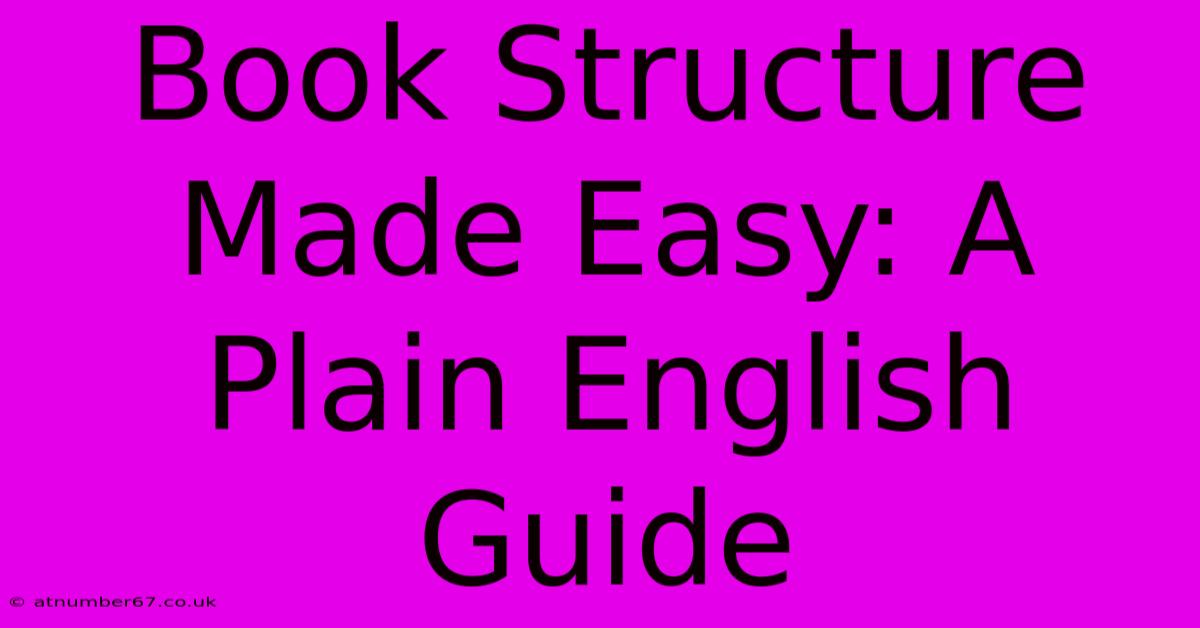Book Structure Made Easy: A Plain English Guide

Table of Contents
Book Structure Made Easy: A Plain English Guide
So you're ready to write a book? Congratulations! That's a huge accomplishment in itself. But before you dive into the exciting world of crafting your masterpiece, you need a solid plan. Understanding book structure is key to keeping your readers engaged and ensuring your story flows smoothly. This guide will break down the essential elements, making the process clear and straightforward.
Understanding the Foundation: Key Structural Elements
Regardless of genre – fiction, non-fiction, memoir – several fundamental elements underpin a well-structured book. Mastering these will significantly improve your writing.
1. The Plot (For Fiction):
- Beginning (Exposition): Introduce your characters, setting, and the initial conflict or problem. Think of this as laying the groundwork for your story. Don't overload readers with information; drip-feed it naturally.
- Rising Action: This is where the tension builds. Introduce complications and obstacles that escalate the conflict, making the stakes higher. This is the heart of your story, keeping readers hooked.
- Climax: The peak of the story's tension. This is the moment of greatest confrontation, where the protagonist faces their biggest challenge. The climax should be memorable and impactful.
- Falling Action: The events immediately following the climax. The tension begins to ease, and the consequences of the climax are revealed.
- Resolution (Denouement): The conclusion of the story. Loose ends are tied up, and the reader is left with a sense of closure (or perhaps a hint of what's to come!).
2. The Narrative Arc (For Both Fiction and Non-Fiction):
The narrative arc isn't just for fiction. Even non-fiction books need a compelling story. It's the journey your reader takes with you, from beginning to end. Think of it as the overall shape of your book's story. A strong narrative arc keeps readers engaged and wanting more.
3. Structure for Non-Fiction:
Non-fiction requires a different approach. While the narrative arc is still important, the structure often depends on the book's purpose:
- How-to guides: Organized step-by-step, often with clear instructions and examples.
- Argumentative books: Present a thesis statement and support it with evidence and reasoning throughout the chapters.
- Biographies: Chronological order is often used, tracing the subject's life from birth to death.
Breaking it Down: Chapters and Scenes
Chapters act as building blocks, dividing your book into manageable sections. Each chapter should have a clear purpose and contribute to the overall narrative. Within chapters, scenes (especially in fiction) are used to show specific events, conversations, or actions, creating a dynamic pace.
Chapter Length: Finding the Right Balance
Don't be afraid to experiment with chapter length. Some authors prefer short, punchy chapters, while others favor longer, more immersive ones. Consider your genre and target audience when making this decision. Consistency is key, however; jarring shifts in length can disrupt the reading flow.
Outlining Your Book: The Roadmap to Success
Before you write a single word, create an outline. This roadmap will guide your writing process, helping you stay focused and avoid getting lost in the details. There are various outlining methods:
- Mind mapping: A visual way to brainstorm ideas and connect them.
- Traditional outlining: A linear approach, listing chapters and key plot points.
- Combination methods: Often the most effective!
Beyond Structure: Essential Elements for Success
Strong structure is only part of the equation. You also need:
- Compelling characters: Readers need to connect with your characters, whether they're likable or not.
- Vivid descriptions: Bring your world to life through sensory details.
- Engaging dialogue: Use dialogue to reveal character and advance the plot.
- Consistent pacing: Keep readers engaged without rushing or dragging the story.
- A satisfying ending: Give your readers the closure they deserve.
Writing a book is a marathon, not a sprint. By understanding and applying these principles of book structure, you’ll be well on your way to creating a compelling and well-organized work that readers will love. Remember, practice makes perfect! So start writing, and don’t be afraid to revise and refine as you go.

Thank you for visiting our website wich cover about Book Structure Made Easy: A Plain English Guide. We hope the information provided has been useful to you. Feel free to contact us if you have any questions or need further assistance. See you next time and dont miss to bookmark.
Featured Posts
-
The Real Story Behind Satoshi Nakamotos Wealth
Apr 01, 2025
-
Unraveling The Mystery David And Sauls Daughters Life
Apr 01, 2025
-
The Changing Face Of Daughterhood In Bengali
Apr 01, 2025
-
Find Your Perfect Galaxy Phone On Tik Tok Budget Friendly
Apr 01, 2025
-
Erzurum Tragedy A Citys Grief
Apr 01, 2025
